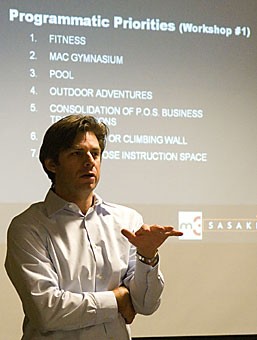A larger fitness area, an outdoor adventures area and a multipurpose activity court gymnasium are a few of the possible changes in store for the Student Recreation Center.
A project team from Sasaki Design Group presented a few of the possible designs for the expansion of the Rec Center at a town hall meeting yesterday, including a plan to triple the size of the fitness area used for weightlifting and cardio exercising.
Students passed a measure in fall 2005 to continue paying $25 a semester until 2041 to fund an expansion of the Rec Center. The current fee pays for the existing center and would have expired in 2011.
Tim Stevens, an architect with Sasaki, said the general consensus is a larger fitness area as the No. 1 priority for the expansion.
“”There is usually a line to get into the fitness center,”” Stevens said. “”Hopefully, by increasing the room by three times, that won’t happen anymore.””
Stevens said the fitness area is the heart of the Rec Center.
“”By putting it up front, we are promoting and advertising it,”” Stevens said. “”We think this would be appropriate for the new design of the center.””
The idea of a multipurpose activity court gymnasium was also on the table because it provides an area to play soccer, volleyball and other sports, Stevens said.
“”The pool ended up being No. 3 on the list of priorities,”” Stevens said. “”We want a pool more for recreational purposes. The pool we have now is more for laps.””
There are also plans to add a bouldering or climbing wall, as well as creating an outdoor adventures area, which would both be in the renovation of the existing Rec Center.
Stevens said the current outdoor adventure area needs to be relocated because its location prevents the expansion.
“”It’s essentially a cork in the wine bottle – it’s hard to drink it unless you pop it out,”” Stevens said.
The design of the new outdoor adventures area is still up in the air, Stevens said.
“”The wish list is huge, but the check we have to pay for it is not,”” Stevens said.
Associated Students of the University of Arizona President Erin Hertzog said the students funded the expansion by voting to pay the $25 recreation fee every semester.
The UA will pay for the Rec Center utilities, Hertzog said.
Tommy Bruce, a business sophomore, said that because all students pay the $25 Student Recreation fee, they should not only expand the popular fitness area but also add facilities to attract new students to the Rec Center.
“”We could have a survey to see what students would like to have,”” Bruce said.
Jami Reinsch, the ASUA administrative vice president, said students should be able to vote for the final design of the new Rec Center.
“”We could have posters with different pictures of designs and the students can vote on which one they want in the lobby of the Rec,”” said Reinsch, a media arts senior.
The project team, M3/Sasaki, will be designing the center for about one year, and construction will begin about this time next year, said Colleen Morgan, facilities project manager for Facilities Design and Construction.
“”We’re heading to first base in the process of expanding the center,”” Morgan said. “”They are the best folks to get us to where we want to go.””
The expansion will be in the neighborhood of 40,000 to 45,000 square feet, Stevens said.









